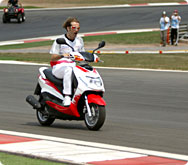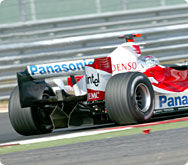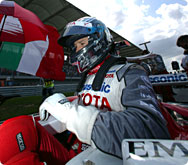| Hello, everyone. Thank you for your support over the weekend. Takahashi here with a report from the Turkish Grand Prix.
• Trying to close the gap with the top teams
So far this season we have been updating our aero parts for each race, and the Turkish Grand Prix was no exception. For Istanbul, we made changes to the floor and the diffuser. It takes quite a bit of time to manufacture floor updates, but I think the time spent is reflected in the finished product.
We didn’t make any changes to our engines. Ralf had a fresh power unit, while Jarno’s engine was on its second race. We were anticipating some extremely hot temperatures for the Turkish GP, but it actually wasn’t too bad. When we actually walked the course for the first time we learned a few things. For one, the track is extremely narrow. There are also a lot of up and down sections, so we knew the circuit would be tougher on the engine and brakes than we expected going in.
While we are still focused on winning team points this year, we also want to make our cars faster—to build momentum going into next season. I think the fundamental difference between Panasonic Toyota Racing and McLaren is in the aerodynamics. If we can put together effective aero packages this year, it will certainly help us going into next. We will continue to make aerodynamic improvements throughout the rest of the season, and hopefully we’ll be able to close the gap by the time we
reach Suzuka. Of course, we’ll make the most of any chance we have to win.
• Friday: A comprehensive program tailored for a new circuit
 |
 |
| The driver's checked out the new course in person. Trulli used a scooter to get his first look at the circuit. |
|
On Fridays we normally focus on tire evaluation, but going into a brand new circuit, we had an additional two tasks to accomplish. The first was to get the drivers experience on the course. The second was to compare the actual on-course data with the data we collected from our simulations. We had to collect a large volume of different types of data, so we were prepared to drive a lot of laps throughout the sessions. I was quite relieved after we completed our program at the end of the day without
any incidents.
During the morning session we focused on learning the characteristics of the course and gathering basic data. The track surface was extremely slippery, so the drivers were extra careful as they were becoming familiar with the circuit—extra care to ensure they stayed on the course. During the afternoon session, a good amount of rubber had built up on the track surface, so we had much better driving conditions. During this time, Ricardo conducted both long runs and performance runs for us.
Thanks to everyone’s efforts, we were able to collect a full complement of data. Most of the data was of the basic sort, related to aerodynamics, front/ rear suspension balance, electronic controls, engine mapping, etc. But there were so much and many kinds to collect throughout the session that we were all very busy. We didn’t find much discrepancy between the actual data and the data from our simulations, so our expectations were that Saturday would be a day for fine-tuning the cars.
The biggest point of difference between our simulation data and actual data was that the track surface grip built up much more quickly than simulations showed. All of our suspicions during our track walk-through were confirmed by the data we collected Friday, and we realized that the circuit would be a fairly vigorous one on the braking systems.
• Saturday: Confusion and clarity
 |
 |
| |
For this race, changes were made to the TF105's diffuser. Panasonic Toyota Racing continues its pursuit of "better and faster." |
During the Saturday morning session everything was thrown into chaos. On Friday, Ricardo’s car had been performing very well, so we implemented his setup on the other cars. But the track was dirty early on Saturday, and the drivers complained of poor grip conditions. We made some adjustments in the aerodynamics and suspension, but things just went from bad to worse. At the end of the Saturday session, Ralf had recorded the 8th best lap time, and Jarno the 12th, but we still didn’t have
a solid setup, and we couldn’t get any more speed, even on new tires.
Having completed an extremely frustrating Saturday morning session, we made the decision to go back to our original setups on the cars. Fortunately, it seems we made the right decision. Jarno was scheduled to make his flying lap 17th in the day, so we expected a good track surface. As luck would have it, the wind direction shifted during the afternoon, and that seemed to cause Jarno to brake conservatively in Turn 12. Other than that slight loss of time, Jarno turned in a flawless attack lap. He
may have been able to go a bit faster, but I still don’t think we would have caught the Renault cars. Ultimately, Jarno got to start on the clean side of the track in P5, so we can’t complain overly about his qualifying results.
Meanwhile, Ralf was perhaps a bit too aggressive on the braking in Turn 9, causing him to go off the track a bit, and losing about a second in the process. During the first half of the run, Ralf was every bit as fast as Jarno, and I’m sure Ralf would have qualified 5th or 6th if everything had gone well. But seeing the number of cars that went off the track during the day, I’m not sure if Ralf’s spot of trouble could have been helped. In the end, Ralf stayed focused and qualified
9th, where he will get a clean track start as well. All in all, I suppose it wasn’t a disastrous qualifying, since both of our cars qualified in the top 10 positions.
• Sunday: Driver determination captures points for Panasonic Toyota Racing
 |
 |
| Jarno qualified P5 and finished P6, marking his eighth in-the-points finish this season. |
|
Our minimum goal was to have both cars finish in the points, but things didn’t go exactly as we hoped. Even so, Jarno finished 6th, earning three points for the team.
Ralf started from the 9th position, and looking back now, I can see that we should have approached Corner 1 with a different strategy. Unfortunately, Ralf had to go quite wide to avoid getting caught up in trouble in the first corner. After that, he reported back that something felt off about the car, and he drove very conservatively until we had a chance to check out the data. Given that, and the fact that Ralf was caught behind slower cars, he wasn’t able to push the pace for quite a while.
And since he couldn’t go faster, air pressure in the tires didn’t come up, trapping Ralf in a cycle of low speed and poor grip. Once we were able to look at the data, we let Ralf know that there weren’t any problems with the car, and he was able to increase his pace gradually. Realizing that finishing order effects the following race, Ralf did his best to finish as high as he could, never giving up. I guess the only thing to say is that we were unlucky to have been caught up in the
mess on Corner 1.
Jarno started the race from P5, and he was able to clear Corner 1 while defending his position. During the first stint, Jarno ran just as we expected, keeping pace with the top cars. The track surface developed quite a bit faster than we projected, so Jarno was able to keep pushing the pace, and we anticipated moving up in position during the latter stages of the race. Unfortunately, the second stint went much slower than we expected, so this is certainly something we’ll have to look back
on to see if we can improve.
When we spoke with the drivers after the race, they told us that the chassis balance was fine, but that the feel in the brakes deteriorated throughout the race. To keep from driving off the course, they had to brake fairly early, the effects of which showed up most significantly in the first sector. Compared to other cars, we lost quite a bit of time there. And this time loss kept us from fighting off and separating from Fisichella and Button. Everyone was quite frustrated to see that we lost position
after the pit stops.
While we acknowledge that our heavy load of fuel may have been part of our lack of speed in the second stint, our engineers are definitely going to have to correct the soft brake issue. In the third stint, we were much lighter on fuel, so there weren’t any problems, and Jarno was able to go much faster. But considering the number of laps left and the distance between the cars both in front and behind, we decided to run a more relaxed race to the finish. As with Ralf, I think Jarno did a very
good job for us today, demonstrating focused driving to the end.
• A battery of tests before the next race at Monza
Between Wednesday and Friday, we’ll have all four of our drivers testing three cars at Monza. One of the cars will have the new V8 engine that’s under development for next season. We’ll be testing a lot of areas, including tires, aerodynamics, chassis and much more. There are only five races left in the season, but we plan on continuing to improve our cars throughout.
As always, thank you for your support, and for visiting the official Panasonic Toyota Racing website. I’ll see you back here with a Keizo report after the Italian Grand Prix at the Monza circuit. Until then…
|